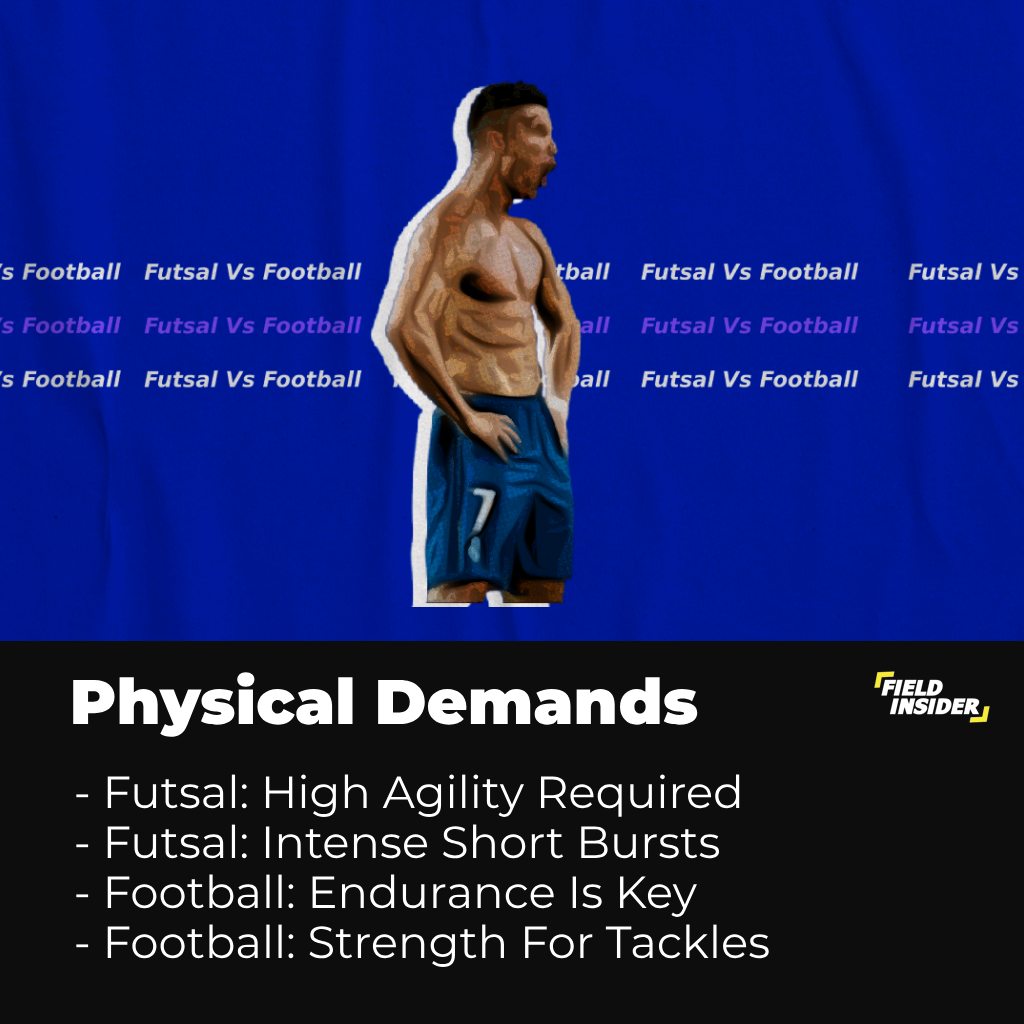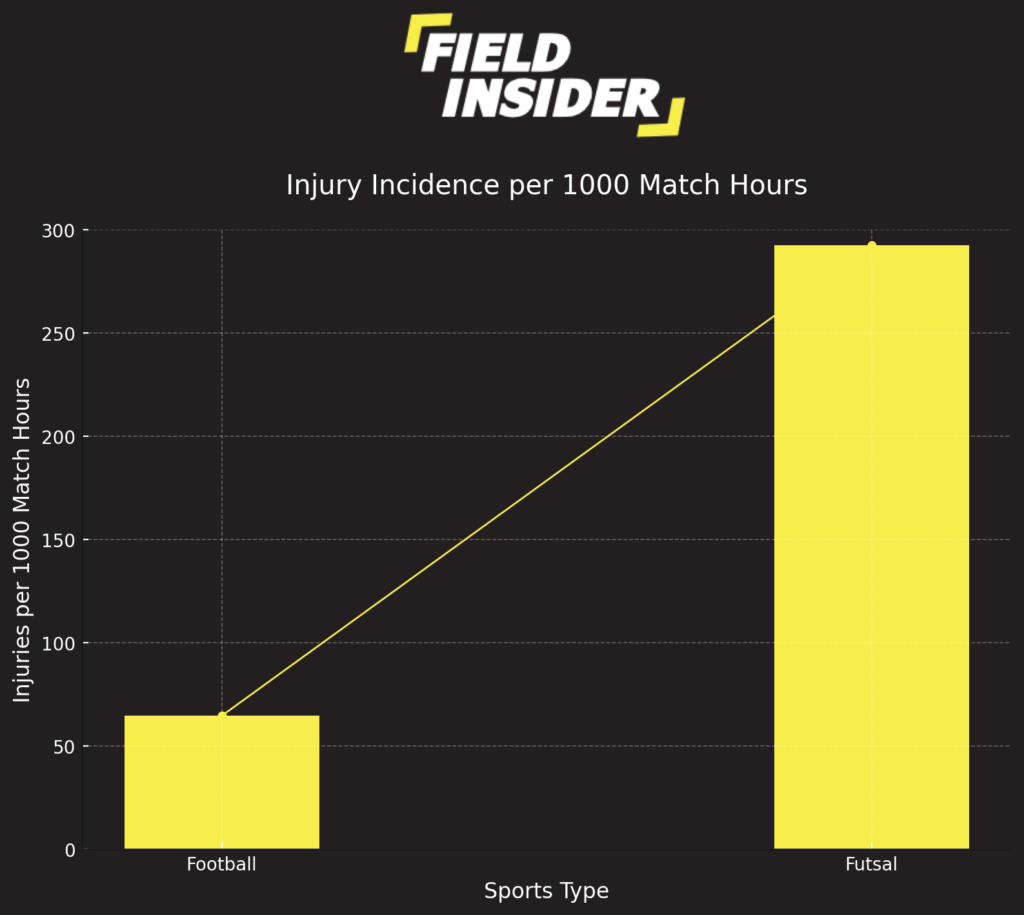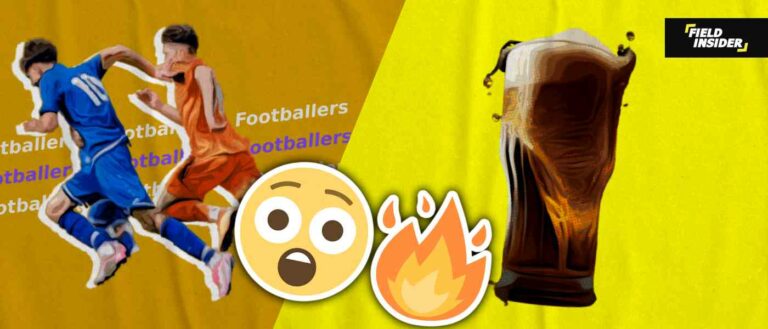Is Futsal Easier Than 11-A-Side Football?
In the evolving landscape of team sports, futsal has rapidly emerged from the shadows of its more globally renowned cousin, 11-a-side football. This surge in popularity begs the question: Is futsal inherently easier, or does its compact format present a unique set of challenges?
This article delves deep into the intricacies of both sports, comparing them across various dimensions such as skill requirements, physical demands, and tactical complexity, to shed light on this intriguing query.
Key Takeaways
| Aspect | Futsal | 11-A-Side Football |
|---|---|---|
| Skill Requirements | Emphasizes close-quarters skills like ball control, passing accuracy, and dribbling in tight spaces. | Demands control in open spaces, passing over longer distances, and varied dribbling skills. |
| Physical Demands | Requires intense bursts of energy and agility, reflecting its fast pace and smaller pitch. | Tests endurance for covering larger distances, along with strength for tackles and aerial duels. |
| Tactical Complexity | Focused on quick decision-making and set plays, fostering immediate tactical adjustments. | Involves broader strategic planning over longer match durations, with adaptability to various formations. |
| Accessibility and Learning Curve | More accessible with smaller pitches and a steeper learning curve, ideal for skill development. | Requires more specialized facilities and has a more gradual learning curve due to tactical and physical complexities. |
Understanding Futsal and 11-A-Side Football
Futsal: A Snapshot
Futsal, often seen as football’s agile and quick-thinking sibling, offers a dynamic and high-paced game environment. Played on a hard court smaller than a football pitch, it typically involves teams of five players. The game emphasizes skillful play and creativity in confined spaces.
The game’s essence is captured through its specialized rules of futsal, designed to encourage fast play and technical finesse. The smaller, low-bounce ball in futsal enhances close ball control and rapid passing. This feature provides a chance for players to display their dribbling skills and tactical savvy.
11-A-Side Football: The Traditional Format
11-a-side football stands as the cornerstone of the global sporting landscape, a testament to its widespread appeal and enduring tradition. Played on a large grass field, this version of football offers a broad canvas for strategic depth and physical endurance.
The rules of 11-a-side football facilitate a game that varies from tight defensive battles to expansive attacking plays, accommodating a wide range of football formations and tactical philosophies.
This format’s vastness tests physical endurance and skill across large distances, alongside strategic planning and adaptability. It’s a thorough examination of both team and individual footballing abilities.
Skill Requirements

Futsal: Mastering the Art of Close Quarters
Futsal places a premium on the ability to control the ball in limited space, making ball mastery a fundamental skill for players. The sport’s emphasis on quick, accurate passing and the necessity for precise ball control under pressure highlight the skills required.
In futsal, the ball is smaller and less bouncy, demanding a higher level of skill to manipulate and retain possession. This focus on close-quarters play enhances a player’s ability to navigate tight situations and also improves their decision-making speed.
Learning to excel in the compact environment of futsal can provide a solid foundation for players. It benefits their performance in wider football contexts as well. The intricate skills developed here are critical, as outlined in our guide on futsal positions .
11-A-Side Football: Commanding the Open Field
In contrast, 11-a-side football extends the battleground, requiring players to adeptly control the ball over larger distances effectively. This format demands the ability to execute long-range passes with accuracy. It also demands the skill to maintain control and strategic positioning across a vast pitch.
The diversity in playing environments—from the dense midfield to the expansive wings—calls for versatile ball-handling skills and the capacity to dribble under varied circumstances. Mastery in these areas is essential for breaking down defenses and creating scoring opportunities.
The strategic application of these skills is evident in the deployment of different football formations, each requiring players to adapt their technical abilities to fit the tactical setup.
Physical Demands

Futsal: Intensity and Agility in Every Move
Futsal is synonymous with high-intensity, rapid-fire gameplay, where the physical demands are centered around short, explosive bursts of energy and superior agility. The smaller playing area and the fast-paced nature of the game require players to constantly accelerate, decelerate, and change direction.
This not only tests a player’s quickness and reflexes but also their stamina, as the game consists of two halves with a continuous clock, leading to very few breaks in play. The relentless pace of futsal places a premium on conditioning, making it an excellent training ground for improving overall football fitness.
11-A-Side Football: Endurance and Strength Across the Pitch
In the expansive world of 11-a-side football, the physical demands extend beyond sheer agility to encompass endurance and strength. Players are often required to cover distances up to 10-12 km in a single match. It is a testament to the endurance levels the sport demands.
This is complemented by the need for physical strength, particularly for defenders and midfielders who engage in aerial duels and tackles.
The larger pitch size and longer duration of matches necessitate a well-rounded physical conditioning regimen that prepares players for the rigors of full-scale football.
The endurance and strength developed in 11-a-side football are fundamental, enabling players to maintain peak performance levels throughout the 90 minutes of play. This aspect of physical preparation is critical, as highlighted in discussions on football fitness.
Unveiling the Risk: Injury Rates in Football vs. Futsal
In a study focused on the incidence of sports-related injuries, a stark contrast emerged between football and futsal.
The study i.e. “Incidence of Football and Futsal Injuries Among Youth in Malaysian Games 2018”, was conducted to analyze the incidence, circumstances, and characteristics of football and futsal injuries.

The findings, illustrated in the bar chart, reveal that despite football and futsal having an equal count of 48 reported injuries, the injury rates per 1000 match hours tell a different story.
For football, the injury rate is considerably lower, at 64.64 per 1000 match hours. This indicates a relatively safer environment for athletes participating in these matches.
Conversely, futsal presents a dramatically different risk profile, with a rate of 292.42 injuries per 1000 match hours. This number is more than fourfold higher compared to football. Several factors might contribute to this higher rate of injury in futsal:
- Playing Surface: Futsal is typically played on hard surfaces. This may contribute to more joint and muscle injuries due to the increased impact compared to the softer grass fields of football.
- Speed of Play: Futsal is known for its fast-paced nature, with players frequently accelerating, decelerating, and changing directions. This may lead to a higher incidence of sprains and strains.
- Player Contact: Although both sports involve player contact, the close quarters of futsal games may increase the likelihood of collisions.
- Game Duration and Intensity: Futsal matches are generally shorter than football matches, but the intensity is constant. It may possibly lead to fatigue-related injuries.
Tactical Complexity
Futsal: Quick Decisions and Tactical Precision
The compact nature of futsal demands not only individual skill and physical prowess but also a high degree of tactical awareness and quick decision-making.
In a game where space and time are at a premium, understanding and executing tactical plans with precision can be the difference between victory and defeat.
Players must be adept at reading the game, anticipating opponent moves, and exploiting fleeting opportunities. The emphasis on set plays, such as those detailed in how to defend in futsal, showcases the importance of rehearsed maneuvers and teamwork in unlocking defenses.
11-A-Side Football: Strategic Depth and Long-Term Planning
Contrastingly, the vast expanse of the 11-a-side game introduces a level of strategic complexity that spans the entirety of the 90-minute match. The larger team size and pitch area allow for a more pronounced emphasis on formations, such as the 4-3-3 formation or the 4-4-2 formation.
Coaches and players must engage in detailed pre-match planning and in-game adjustments, tailoring their approach to exploit opponent weaknesses. This strategic depth requires a thorough understanding of the game’s principles, from defending in numbers to orchestrating coordinated attacks.
Players must adapt to various tactical scenarios, whether pressing high up the pitch or defending deep, making adaptability and tactical intelligence key attributes. The ability to maintain focus and execute a strategic plan over longer periods is crucial, reflecting the game’s demand for tactical foresight.
Accessibility and Learning Curve

Futsal: Gateway to the Sport
Futsal stands out for its accessibility and the steep learning curve it offers to newcomers. The requirement for minimal equipment and smaller playing spaces makes it easier for individuals to get involved in this sport.
This ease of access is a significant advantage, particularly in urban areas where space is at a premium. Moreover, the nature of futsal, with its focus on technical skills and quick play, allows beginners to rapidly develop fundamental footballing skills such as ball control, passing, and spatial awareness.
11-A-Side Football: Gradual Skill Development
In contrast, 11-a-side football presents a more gradual learning curve, necessitated by its complexity and the physical dimensions of the game. Accessing full-sized pitches and forming teams of eleven can be challenging, particularly for those just starting in the sport.
However, this traditional format of football offers a comprehensive framework for skill development, covering a broad spectrum from technical skills to physical conditioning. The structured environment of 11-a-side football provides a solid foundation for players to refine their abilities over time.
Comparative Overview: Futsal vs. 11-A-Side Football
| Characteristic | Futsal | 11-A-Side Football |
|---|---|---|
| Pitch Size | 25-42m x 16-25m | 90-120m x 45-90m |
| Ball Size | Size 4 (62-64 cm circumference) | Size 5 (68-70 cm circumference) |
| Number of Players | 5 players (including goalkeeper) | 11 players (including goalkeeper) |
| Match Duration | 2 halves, 20 minutes each (stoppage time) | 2 halves, 45 minutes each |
| Goal Size | 3m x 2m | 7.32m x 2.44m |
| Ball Type | Low bounce | Standard bounce |
| Substitutions | Unlimited, rolling | Limited to 3-5 (depending on the competition) |
| Playing Surface | Indoor, hard surface | Outdoor, grass |
Conclusion
Deciding whether futsal is easier than 11-a-side football is not straightforward. Futsal, with its emphasis on skillful play in tight spaces and quick thinking, contrasts with the endurance, strategic depth, and versatility required in 11-a-side football.
Rather than viewing one as easier than the other, it’s more productive to see them as complementary, each offering valuable lessons and enjoyment. We encourage enthusiasts and aspiring players to experience both formats, discovering firsthand which style resonates more with their personal preferences and strengths.








